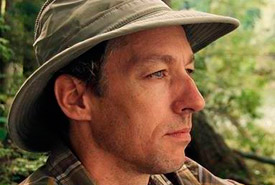Painting Big Trout Bay
![Réjean Roy. <i>Piercing light, McKellar Point </i>[cropped], 2017. Oil on panel, 24 x 30 inches. © Réjean Roy](https://www.natureconservancy.ca/assets/images/blog/piercing-light-mckellar-point-lr-thumb.jpg)
Réjean Roy. Piercing light, McKellar Point [cropped], 2017. Oil on panel, 24 x 30 inches. © Réjean Roy
The pursuit of art is a solitary endeavour. Most artists tend to follow their own personal lead, motivated by self-expression. Even though their muse might be an object, person or an event, they recognize inspiration by being attuned to their own emotion, or through process. This is then translated, with hopefully some success, onto a canvas, through sculpture or another medium.
My own inspiration for my work rests solely on nature. For as long as I can remember, I’ve been enchanted by the forest, rivers and lakes. Now, as a professional artist, I often go on canoe or hiking trips to find new and enticing compositions as inspiration. These trips are also an opportunity to immerse myself in the natural world. I tend to work while on a trip and soon after, so that the memory of the experience is still fresh in my mind. It would be difficult for me to paint a winter scene in the middle of summer, and, as such, my work tends to follow the seasons.
![Réjean Roy. <i>Sun and Ripples</i> [cropped], 2017. Oil on panel, 20 x 24 inches. © Réjean Roy](https://www.natureconservancy.ca/assets/images/blog/sun-an-ripples-lr-thumb.jpg)
Réjean Roy. Sun and Ripples [cropped], 2017. Oil on panel, 20 x 24 inches. © Réjean Roy
Even though creative art is solitary, it is only by sharing the final product that its true essence is revealed. So when I was invited by the Nature Conservancy of Canada (NCC) to paint the wonderful landscape of Big Trout Bay, along Lake Superior, I was first enthralled by the idea of discovering new landscapes, but also glad to represent, through art, a project that means a lot to many people. As I learned that a group of dedicated people had been able to acquire a morsel of habitat here to be protected for generations to come, my heart sang a little louder.
Earlier this summer, I spent more than a week exploring the many facets of Big Trout Bay, probing its character. I appreciated having my kayak, enabling me to follow the shoreline around McKellar Point. I also had the opportunity to go out on a motor boat with staff from NCC on an exceptionally calm day. This gave me the basis for my paintings Sun and Ripples and Rocky Shore.
![Réjean Roy. <i>Top view of McKellar Point </i>[cropped], 2017. Oil on panel, 10 x 12 inches. © Réjean Roy](https://www.natureconservancy.ca/assets/images/blog/top-view-of-mckellar-point-sketch-lr-thumb.jpg)
Réjean Roy. Top view of McKellar Point [cropped], 2017. Oil on panel, 10 x 12 inches. © Réjean Roy
Big Trout Bay is a wild landscape, but there is at least one trail that permits a hiker to gain higher ground and fully appreciate the property from a bird's-eye view. Top View of McKellar Point, among others, is a reflection of that. I did many sketches from those cliffs, which tower above Little and Big Trout Bay.
Another discovery (with the help of Gary Davies, NCC's program director for northwestern Ontario) that was very interesting was the short portage between Big Trout Bay and Little Trout Bay. This portage crosses McKellar Point at its narrowest. Using this portage, I was able to reach and walk along the opposite shore when the weather became too dangerous for small vessels to venture out in the open and away from protective bays. This gave me a view of the Cloud Islands — that is, when the fog wasn’t too thick!
![Réjean Roy. <i>Cliff of Little Trout Bay </i>[cropped], 2017. Oil on panel, 16 x 20 inches. © Réjean Roy](https://www.natureconservancy.ca/assets/images/blog/cliffs-of-small-trout-bay-lr-thumb.jpg)
Réjean Roy. Cliff of Little Trout Bay [cropped], 2017. Oil on panel, 16 x 20 inches. © Réjean Roy
While exploring Big Trout Bay, I battled strong winds, dodged heavy rain, endured bug bites and suffocating heat, all the while trying to capture the magnificent landscape displayed along the shore of Lake Superior. The sketches are for me testimonies of those moments.
And then, enriched by all those experiences, I eventually returned to my home studio, where I tackled larger works. I consider this collection of paintings a celebration of nature and of the beauty of conservation.
Hope to see you on the trail.
To learn about and see more of Réjean Roy’s work, click here.


